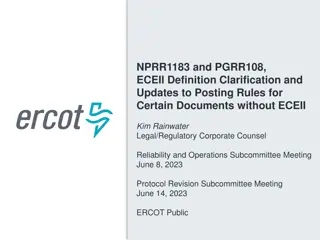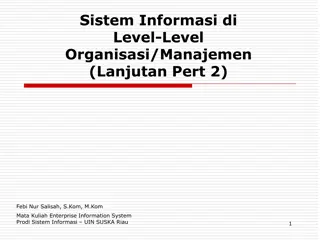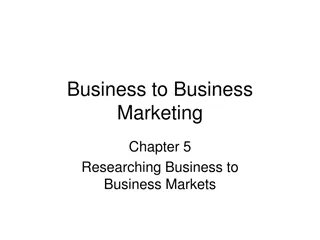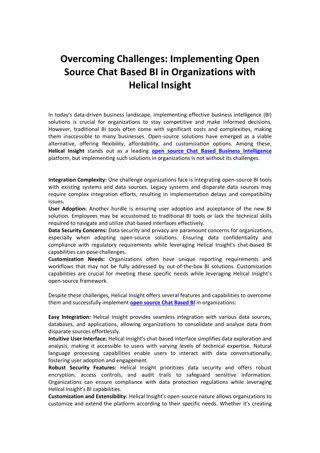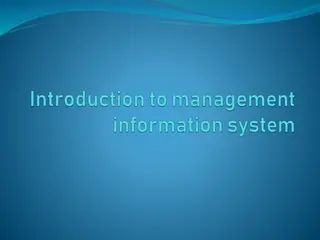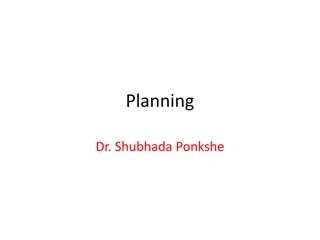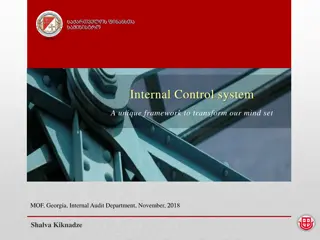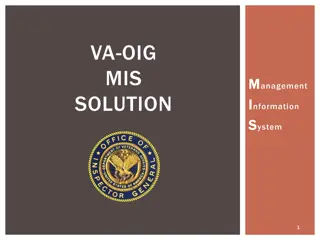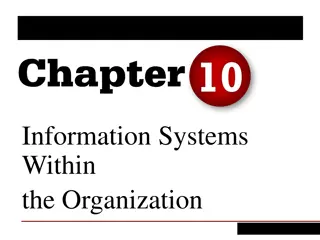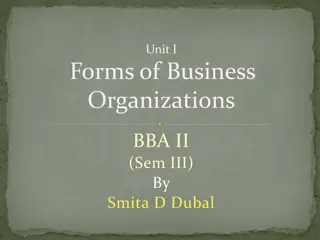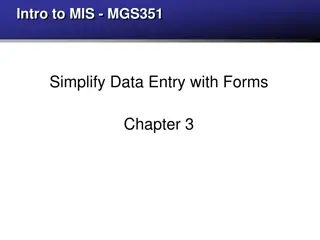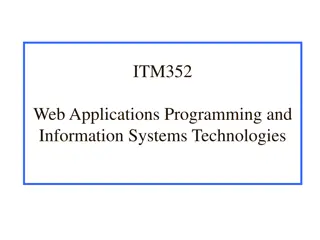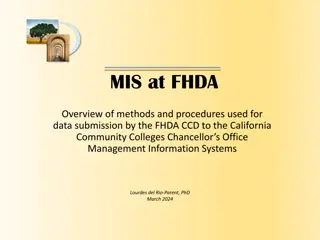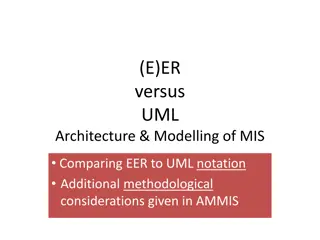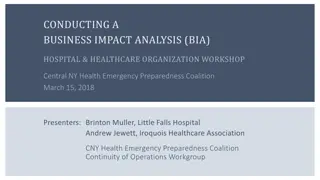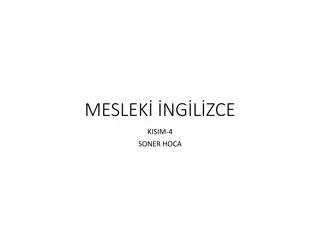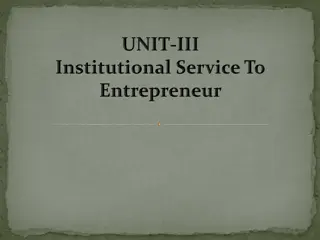Management Information Systems (MIS) in Business Organizations
Explore the world of Management Information Systems (MIS) in business settings, covering topics such as sales, supplier management, purchase orders, forecasting, stock details, customer orders, dispatch instructions, financial transactions, and more. Gain insights into the role of MIS in bringing organizations together through Enterprise Resource Planning (ERP) systems and historic development. Delve into the components of MIS, including management principles, information processing, and system functions. Learn about the importance of data processing and its value in decision-making processes, highlighting the reduction of uncertainty and ambiguity through effective information management.
Download Presentation

Please find below an Image/Link to download the presentation.
The content on the website is provided AS IS for your information and personal use only. It may not be sold, licensed, or shared on other websites without obtaining consent from the author.If you encounter any issues during the download, it is possible that the publisher has removed the file from their server.
You are allowed to download the files provided on this website for personal or commercial use, subject to the condition that they are used lawfully. All files are the property of their respective owners.
The content on the website is provided AS IS for your information and personal use only. It may not be sold, licensed, or shared on other websites without obtaining consent from the author.
E N D
Presentation Transcript
A Business - MIS Sales Supplie r Purchase Order Forecast Order Stock Details Material Customer Order Customer Dispatch Instruction Order Acceptance Goods & Invoice Delivery Doc & Invoice Warehouse Stock Details Ins. Report Customer Invoice RM Issue Production Accounts Ins Req FG Receipt Payment Work In Progress (WIP) Vendor Invoice Quality Payment
BRINGINGTHE ORGANIZATION TOGETHER ERP The organization before ERP
BRINGINGTHE ORGANIZATION TOGETHER ERP bringing the organization together
I. MANAGEMENT INFORMATION SYSTEMS A. Management: What is management? B. Information: What is information? C. Systems: What are systems? 9
MANAGEMENT INFORMATION SYSTEMS A. Management: What is management? Management is group of individuals who does : 1. Planning - Goal setting, Environmental scanning, Forecasting and Data collection 2. Organizing - Staffing, Coordinating, Delegating, Understanding, Procedures/ Policies 3. Leading- Authority, Motivating, Directing ( Delegation of responsibilities ) activating, Supervising, Negotiation and Persuading 4. Controlling - Controlling: Resources- Money (capital), manpower (people), materials, machines, movement (Distribution, flow), and Information. Measuring, Evaluating , Reporting, corrective action and feed back 5.Communicating: Goals/Objectives, standards of desirability. Informing, Persuading, Negotiation, Corrective action, Listening 10
MANAGEMENT INFORMATION SYSTEMS Information: What is information? B. A definition: Information is data that has been processed into a form that is meaningful to the recipient (USER) and is of real or perceived value in current or prospective actions or decisions. 1. Data (raw material)- Alpha-numeric and Symbolic : Stored facts, inactive (they exist), technology based and gathered from various places 2. Processed data :meaningful, perceived value, motivating action, HAS SURPRISE VALUE, HAS NEWS VALUE, Presented facts, active (it enables doing), business based (Domain based) and transformed form data 3. Model : entity, attribute and relationship 4. Reduces Uncertainty 5. Reduces Equivocal (ambiguity) 6. Knowledge/Power 7. Send/Receive Messages 11
MANAGEMENT INFORMATION SYSTEMS C. Systems Concepts: What are systems? physical system is a set of components (subsystems or elementary parts) that operate together to achieve a common objective (or multiple objective). Input-process-output an orderly arrangement of interdependent ideas or constructs (ABSTRACT SYSTEM) a set of elements which operate together to accomplish an objective (PHYSICAL SYSTEM) 1. 2.
Transforming Data Into Information Data Inputs Information Outputs Query Response External Data Internal Data Capture Decision Outcome Manipulation Expert-System Advice Storage Transaction Document Provision of Access at User Location Report Information System 13 Organization Environment
DATA, INFORMATION, AND SYSTEMS Generating Information Computer-based ISs take data as raw material, process it, and produce information as output. 14
MIS Data vs. Information Data A given, or fact; a number, a statement, or a picture Represents something in the real world The raw materials in the production of information Information Data that have meaning within a context Data in relationships Data after manipulation Data Analyses: Example: customer survey Reading through data collected from a customer survey with questions in various categories would be time-consuming and not very helpful. When manipulated, the surveys may provide useful information. 15
MIS Information in Context
Meaning of MIS 1. An organized approach to the study of the information needs of an organization's management at every level in making operational, tactical, and strategic decisions. Its objective is to design and implement procedures, processes, and routines that provide suitably detailed reports in an accurate, consistent, and timely manner. 2 .In a management information system, modern, computerized systems continuously gather relevant data, both from inside and outside an organization. This data is then processed, integrated, and stored in a centralized database (or data warehouse) where it is constantly updated and made available to all who have the authority to access it, in a form that suits their purpose.
Meaning of MIS MIS is the system, which makes available the right information to the: Right Person At Right Place At right time In the right format/form At right cost. 3.
Definition of MIS Lucey, defines MIS as a system to covert data from internal and external sources into information to communicate that information in an appropriate form to managers at all levels, in all functions to make timely and effective decisions for planning, directing and controlling the activities for which they are responsible
WHATIS MIS? A system to convert the data from internal and external sources into information and to communicate it in an appropriate manner, to managers at all levels and helps in taking timely and effective decisions for planning, directing and controlling the activities for which they are responsible.
Need, Purpose and Objective of MIS Decision making Problem Solving Controlling Getting competitive edge
GLOBALISATION Worldwide marketplace 24x7 nature Firms can achieve extraordinary cost reductions by finding low-cost suppliers and managing production facilities in other countries. Google, e-bay, amazon .
THEEMERGINGDIGITALFIRM A digital firm is one in which nearly all of the organisation s significant business relationships with customers, suppliers, and employees are digitally enabled and mediated. Core business processes through digital networks spanning the entire organisation or linking multiple organisations Developing a new product, generating and fulfilling an order, creating a marketing plan, and hiring an employee .. Time shifting and space shifting are accomplished
MIS ASANINSTRUMENTFORTHE ORGANIZATIONAL CHANGE External Change 1. MIS has made world smaller 2. Worldwide reorganization environment and attempt to control the calamity. 3. Health conscious among the group leading less sufferings 4. Change in the work lifestyle for better result 5. Creating Knowledge is an assets Internal Change 1. MIS will change the Business Process 2. MIS will change the old standards and set new standards 3. MIS key for Continuous improvement Process 4. MIS will reduce the hierarchy and hence less operation cost 5. MIS focus on Shared information 6. MIS will accelerate restructure work flow for both line and staff functions. 7. MIS will bring change in Authority and power by merit and not by age or number of years of experience. 8. MIS brings cultural change. 9. MIS measures the results and performance. 10. MIS brings Continuous addition to Organizational knowledge base. Is MIS instrument for Changes ? Yes
INFORMATIONAS STRATEGIC RESOURCE Yes . Information is Strategic Resources. Because Information helps in taking Strategic, Tactical and operational Decisions. It is one of critical and importance resource. It helps us understand Cost, Quality, price, technology, productivity and product. It helps to smooth following of business process and there by smooth managing of business operation. It helps to maintain the business standards like ISO, QS, CMMI, Six Sigma etc. It helps to be ahead in the competition It helps company in analyzing their own SWOT It helps in maintaining it s own profitability. It will help in taking new business decisions like new plant, new product, new business line etc. It protects company from business cycles. It provides future direction to the organization. It provides the competitive edge. 1. 2. 3. 4. 5. 6. 7. 8. 9. 10.
USEOF INFORMATIONFOR COMPETITIVE ADVANTAGES A. According Porter Miller: Information helps in following: 1. Change in industry structure: this includes Five Forces: 1. Customers bargaining power 2. Suppliers bargaining power 3. Threats of new entrant in market 4. Pressure from substitute products and services and 5. Existing Industry competitors 2. Birth of new business/new business initiatives 3. New ways of doing business B. Functional Use: 1. Lower the cost 2. Information and information system facilitate value chain e.g. product delivery, quality 3. In increased the speed, accuracy and timeliness of the organization 4. It helps in simplifying the business processes 5. It helps organization in meeting the standards and benchmarks C. Strategic Use 1. New way of doing the work 2. New way of dealing in Product differentiation 3. It helps in new way of developing strategies, planning, forecasting and monitoring 4. It helps in problem solving and decision making by extensive internal and external data analysis. 5. It improves the ability to perform 6. It helps in getting advantages of market situation and keeps ahead in the competition. 7. It helps in eliminating waste, inefficiencies and gaps in the business operations 8. Provides the flexibility and helps manage the uncertainties 9. Analysis external information and making use of business
STRATEGICOBJECTIVESOF INFORMATION SYSTEMS: 1. OPERATIONALEXCELLENCE Higher levels of efficiency and productivity in business operations
STRATEGICOBJECTIVESOF INFORMATION SYSTEMS: 2. NEW PRODUCTS, SERVICESAND BUSINESS MODELS Information Systems and technologies are a major enabling tool for firms to create new products and services as well as entirely new business models
STRATEGICOBJECTIVESOF INFORMATION SYSTEMS: 3. CUSTOMERAND SUPPLIER INTIMACY More you know your customers and serve them well, the more they respond by returning and purchasing more. More you engage your suppliers, the better the suppliers can provide vital inputs.
STRATEGICOBJECTIVESOF INFORMATION SYSTEMS: 4. IMPROVEDDECISIONMAKING Forecasts Best Guesses Over production and under- production of goods Luck ! Customers Cost poor allocation of resources Poor response times
STRATEGICOBJECTIVESOF INFORMATION SYSTEMS: 4. IMPROVEDDECISIONMAKING
STRATEGICOBJECTIVESOF INFORMATION SYSTEMS: 5. COMPETITIVEADVANTAGE Doing things better than your competitors Charging less for superior products Responding to customers and suppliers in real time mass customisation
STRATEGICOBJECTIVESOF INFORMATION SYSTEMS: 6. SURVIVAL Investment in IS and technologies are becoming necessities of doing business.
Contemporary (modern) Approaches to MIS Contemporary MIS systems involve one or more computers, working in concert, to achieve the stated goals of an organization. The function is always the same, but the desired results fluctuate with the specific goals and needs of individual organizations. Since the universal language of commerce is numbers, using the incredible speed of computers, MIS systems achieve their function amazingly well. Technical Approach: It includes mathematical and normative Rely on physical technology and formal capabilities of systems Computer science, management science and operation research contributes significantly. Behavioral Approach: Depends on Developer consider- behavioral aspects political science, psychology, sociology and organizational behavior. Socio-Technical Approach.- it include both technical as well as behavioral approaches. The most important features of contemporary MIS systems involve flexibility and reasonable cost. In the world of business, it matters little what industry you are in, how large or small the company may be and how computer savvy the management is. There are MIS systems that are easy to use, affordably priced and immensely reliable available to all businesses.
CHARACTERISTICSOF MIS I. Management-oriented: The basic objective of MIS is to provide information support to the management in the organization for decision making. So an effective MIS should start its journey from appraisal of management needs, mission and goal of the business organization. It may be individual or collective goals of an organization. The MIS is such that it serves all the levels of management in an organization i.e. top, middle and lower level. II. Management directed: When MIS is management-oriented, it should be directed by the management because it is the management who tells their needs and requirements more effectively than anybody else. Manager should guide the MIS professionals not only at the stage of planning but also on development, review and implementation stages so that effective system should be the end product of the whole exercise in making an effective MIS. III. Integrated: It means a comprehensive or complete view of all the sub systems in the organization of a company. Development of information must be integrated so that all the operational and functional information sub systems should be worked together as a single entity. This integration is necessary because it leads to retrieval of more meaningful and useful information. IV. Common data flows: The integration of different sub systems will lead to a common data flow which will further help in avoiding duplicity and redundancy in data collection, storage and processing. For example, the customer orders are the basis for many activities in an organization viz. billing, sales for cashing, etc. Data is collected by a system analyst from its original source only one time. Then he utilizes the data with minimum number of processing procedures and uses the information for production output documents and reports in small numbers and eliminates the undesirable data. This will lead to elimination of duplication that simplify the operations and produce an efficient information system. V. Heavy planning-element: The preparation of MIS is not a one or two day exercise. It usually takes 3 to 5 years and sometimes a much longer period. So the system expert has to keep 2 things in mind one is that he has to keep future objectives as well as the firm s information well in advance and also he has to keep in mind that his MIS will not be obsolete before it gets into action.
CHARACTERISTICSOF MIS VI. Sub System concept: When a problem is seen in 2 sub parts, then the better solution to the problem is possible. Although MIS is viewed as a single entity but for its effective use, it should be broken down in small parts or subsystems so that more attention and insight is paid to each sub system. Priorities will be set and phase of implementation will be made easy. While making or breaking down the whole MIS into subsystems, it should be kept in mind that the subsystems should be easily manageable. VII. Common database: This is the basic feature of MIS to achieve the objective of using MIS in business organizations. It avoids duplication of files and storage which leads to reduction in costs. Common database means a Super file or Master file which consolidates and integrates data records formerly stored in many separate data files. The organization of the database allows it to be accessed by each subsystem and thus, eliminates the necessity of duplication in data storage, updating, deletion and protection. VIII. Computerized: MIS can be used without a computer. But the use of computers increases the effectiveness and the efficiency of the system. The queries can be handled more quickly and efficiently with the computerized MIS. The other benefits are accuracy, storage capacity and timely information. IX. User friendly/Flexibility: An MIS should be flexible i.e. there should be room for further modification because the MIS takes much time in preparation and our environment is dynamic in nature.MIS should be such that it should be used independently by the end user so that they do not depend on the experts. X. Information as a resource: Information is the major ingredient of any MIS. So, an MIS should be treated as a resource and managed properly




